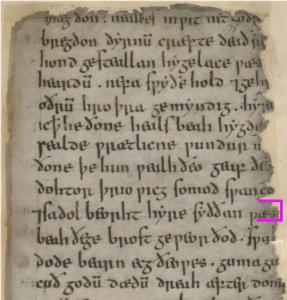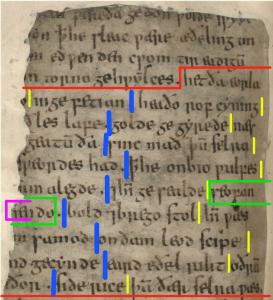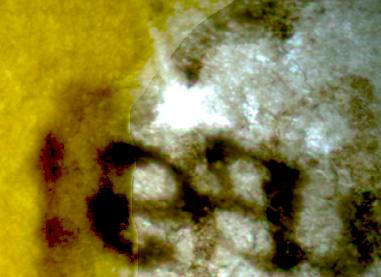|
In section XXXI of the manuscript, Beowulf gives to his king Hygelac the gifts which he had received from Hrothgar, and Hygelac gives things to Beowulf in return. In lines 2177-2189 it is explained that when Beowulf was younger, people had thought he was "no good," but that his courage in Heorot had now redeemed his reputation, and brought him honor in his community.
In lines 2190-2199, Hygelac gives Beowulf an heirloom sword, land, a hall, a throne, and "seven thousand." It is then pointed out that both men had a native right to own land, but that Hygelac, by his superior rank, still had more land, and ruled the kingdom.
Accoring to Michael Alexander (page 144), the translation of Chickering's "gesealde seofan þûsendo" is "gesellan (give) seofon (seven) þûsend (thousand)"
Note that since þ (pronounced "thorn") is the modern equivalent of th -- with both a soft pronunciation as in modern "thick," and a hard pronunciation as in modern "then," -- if you pronounce þûsend using modern pronunciation you get something very close to the modern "thousand."
There has been a lot of discussion about exactly what the "seven thousand" (seofan þûsendo at line 2195b) refers to. Seven thousand what?
| Het ðâ eorla hleˆo |
in gefetian, |
2190 |
Then the battle-bold Hygelac, |
protector of nobles, |
| heðo-rôf cyning, |
Hrêðles lêfe, |
|
had them bring out |
the heirloom of Hrethel, |
| golde gegyrede; |
næs mid Gêatum ðâ |
|
covered with gold; |
at that time in Geatland |
| sinc-mâðþum sêlra |
on sweordes hâd; |
|
there was no greater treasure |
in the form of a sword; |
| þæt hê on Bîowulfes |
bearm âlegde, |
|
he laid that blade |
on Beowulf's lap |
| ond him gesealde |
seofan þûsendo, |
2195 |
and gave him lands, |
seven thousand hides, |
| bold ond brego-stôl. |
Him wæs bam samod |
|
a hall, and gift-throne. |
Both of them together |
| on ðâm lêod-scipe |
lond gecynde, |
|
had inherited land |
within that nation, |
| eard, êðel-riht, |
ôðrum swîðor, |
|
the native right |
to hold the homeland, |
| sîde rîce, |
þâm ðær sêlra wæs. |
|
but the higher in rank |
rules the kingdom. |
Above is the Chickering translation of lines 2190-2199, with Chickering's italics where words must be inferred due to damage in the manuscript. Note, for instance, that in the manuscript (shown below), at the beginning of the sixth line in this folio, is "ðles", which Chickering shows as Hrêðles, with "Hrê" in italics, to show that the first 3 letters are inferred (this is called "emending"the text -- the little textual additions are called "emendations"). Below are images of this section in the manuscript.


|
|
These images of the original manuscript is of the first 13 lines of folio 178r (recto side) and 178v (verso side) (from the Electronic Beowulf CD by Kevin Kiernan). They are the front and back of the same piece of leather parchment, which is why the right edge of the left-hand image, and the left edge of the right-hand image match up. You can click either image to see a 1657 pixel high version (260k in size).
This is the section in the manuscript where the scene transcribed here appears.
I have inserted red lines to demarcate the beginning and ending of the section, with heavy blue vertical lines corresponding to the end of each line in the poem, and medium-weight yellow vertical lines corresponding to the end of the the first half-line on each line, and green lines to outline the words seofan þûsendo, which is translated as seven thousand.

Here is the close-up image of the section marked in purple on the images above (from the Electronic Beowulf CD by Kevin Kiernan). Professor Kiernan took this image from the verso side of the manuscript (the page on the right in the images above). He shone high-intensity light through from the back, which is why you see the æ from the recto side shining through (backwards, because it is coming through from the recto side). In his note for this image, he says "10. þusendo AB; now þ gone, u covered, and middle of s-shaft cut by a small hole (second side of u, s, and e obscured here by shine-through of æs)." When he refers to "AB", he means Thorkelin transcripts A and B, which were made before the paper frames were put around the manuscript. When he uses "10." he means line 10 of this folio, 178v.
Notice that the paper frame (into which each of the 70 manuscript folios were mounted by Henry Gough in August, 1845 -- 114 years after the Ashburnham House fire had damaged the manuscript) shows clearly on Kevin Kiernan's close-up image. Each folio is slightly larger than its paper frame by a few millimeters. The edges of the folio are glued to the paper frame, and then a 19th century version of Scotch tape is pasted on the other side. That is why the edges of the folio on the right image (verso side) are smoother than those on the left image (recto side): the paper frame is on top in the right-hand image, and so the edges you see are the cut edges of the paper frame, whereas the manuscript is on top in the left image, and so the edges you see are those of the manuscript, which were damaged in the fire in on October 23, 1731. You can also see the clear tape on the left image, which shows you that the manuscript edges are sandwiched between the paper frame, and the tape. People have often lamented the fact that the paper frames hide the edges of the manuscript, but Professor Kiernan's photographs show that you can often see through the paper frame when you use the right lighting, and so we get the benefit of the frames having preserved the edges of the manuscript, without much loss. We are all indebted to Kevin Kiernan for his work in the Electronic Beowulf project, in which detailed images of the manuscript are brought to the masses for the first time. The Electronic Beowulf CD (which sells for $150) contains hundreds of detailed images like the one above, plus many many other images and resource materials for study of the manuscript.
|
Here is what each translator has assumed about the seven thousand:
D. H. Crawford (1926),
Lesslie Hall (1892),
John Mitchell Kemble (1835,37),
Charles Scott Moncrieff (1921)
William Morris & A. J. Wyatt (1898),
and
Benjamin Thorpe (1865),
leave it as "seven thousand." Thorpe, in his footnote for this phrase, says "This expression has undergone many attempts at explanation, but none of them satisfactory."
Albert C. Baugh (1925),
Howell D. Chickering Jr. (1977),
John Earle (1892),
Seamus Heaney (2000),
G. H. Gerould (1929),
Bernard F. Huppe (1987),
Charles W. Kennedy (1940),
Bertha Rogers (2000),
Robert Shafer (1927)
,
Hazelton Spencer (1951)
,
and
Michael Swanton (1978),
have, in their translations, the phrase seven thousand hides.
In his footnote Albert C. Baugh (1925) says "A measure of land sufficient to support a family," and in his footnote
Michael Swanton (1978) says that he has used hides because of Thorpe.
Gavin Bone (1946),
S. A. J. Bradley (1995),
John R. Clark Hall (1911),
Kevin Crossley-Holland (1999),
G. N. Garmonsway (1971),
Constance B. Hieatt (1967),
John McNamara (2005),
Lucien Dean Pearson (1965),
John Porter (1993),
Burton Raffel (1963),
E. L. Risden (1994),
Gildas Roberts (1984),
E. V. Sandys (1941),
Archibald Strong (1925),
and
David Wright (1957)
say that it is seven thousand hides of land.
-
Harry Morgan Ayres (1933)
says that it is a domain of seven thousand hides.
-
Louis J. Rodrigues (2002)
writes seven thousand [hides of land] in his edition
-
Stanley B. Greenfield, Alain Renoir (1982)
also uses hides of land, and in a footnote indicates that this is "The equivalent of the size of North Mercia, a considerable area."
-
Roy M. Liuzza (2000),
uses hides of land, and his footnote says "The hide is a unit of land, originally the amount of land which could support a peasant and his family; its actual size varied from one region to another. Seven thousand hides is by any measure a very generous area."
-
Donald A. Mackenzie (1995)
,
writes a gold-headed sword, much money, a country seat, and the rank of a prince.
-
Marijane Osborn (1983),
says a great estate of seven thousand hides, and in a footnote says "A 'hide' varies according to time and place; sometimes it is as much as 120 acres" and in an endnote says "A hide of land has been described as the amount of land required to maintain one free household, or the amount that may be plowed by an ox in a year. The actual acreage varies greatly according to place and period. In his History (III, 24), Bede mentions that the size of North Mercia is seven thousand hides, the same land measure that the poet gives us for Beowulf's estate."
-
A. Sullivan & T. Murphy (2004),
call is a spacious estate.
- Francis B. Gummere (1910)
uses seven thousand, and then in a footnote says "This is generally assumed to mean hides, though the text simply says seven thousand. A hide in England meant about 120 acres, though the size of the acre varied."
-
William Ellery Leonard (1923)
uses hides, and his footnote says "Probably seven thousand hides (a hide = 120 acres) of land -- a demesne as large as a feudal dukedom."
-
A.D. Wackerbarth (1849)
writes seven thousand Vills to own, and has the following footnote:
-
Lieut.-Colonel H.W. Lumsden (1883)
writes And house withal, with thousands sev'n
-
C. L. Wrenn, W. F. Bolton (1953)
have the Old English version only, and a footnote that says "i.e. seven thousand hides of land. Klaeber notes that this was the size of North Mercia acording to Bede (iii, 24) in his time."
- The
Alfred J. Wyatt, R. W. Chambers (1914)
Old English version has a footnote that says "Probably 'seven thousand hides of land,' which would be an earldom of the size of an English county. [Cf. Kluge in P.B.B. ix. 191 and 2994.]"
- The Old English
George Jack Edition (1997)
has a footnote that says "'seven thousand', i.e. seven thousand hides of land; þûsend is sometimes used of value without expression of the unit (which is understood from the context). A hide was the normal holding of a peasant, sufficient to support a ceorl and his household; its extent varied (Stenton 1971: 279)."
- The
Bruce Mitchell, Fred C. Robinson (1998)
Old English version has a footnote that says "'seven thousand [hides of land]'. The size of a hid varied greatly."
In the
John Josias Conybeare (1826)
translation (the earliest modern-English translation available) we read:
The narrative of Beowulf extends nearly to the middle of the 29th Canto. We are then informed that the hero made over the more valuable of Hrothgar's presents to his own sovereign, who in return confers on him a splendid ornament or order of knighthood, and a fief or principality containing seven thousand vassals. In process of time, yet further gifts and honours were heaped upon him; and after the death of Higelac and his son Hearede, who appear both to have fallen in battle, he was called to fill the throne of the Scylfings.
In the
Michael Alexander (1973)
translation it is an estate of seven thousand hides.
Clarence Griffin Child (1904)
says seven thousand pieces.
Edwin Morgan (1952)
uses the phrase the value of seven thousand -- acres and capital and castle.
Barry Tharaud (1990)
says seven thousand hectares of land.
A. Wigfall Green (1935)
asks, in a footnote, whether seven thousand refers to measures of land.
Robert Kay Gordon (1923/1992) and Albert W. Haley (1978)
also say that it is measures of land.
Here is what it says in the Richard M. Trask (1998) bilingual translation:
| On Beowulf's lap he laid it down |
| Þæt he on Biowulfes bearm alegde |
| and gave him land acres, eight hundred thousand-- |
| ond him gesealde seofan þusendo, |
| buildings and high thrones |
| bold ond bregostol. |
I wrote to Richard Trask to ask him about this eight hundred thousand, but he did not write back.
Paula Grant (1995)
says that it is seven thousand holdings to rule.
Marc Hudson (1990)
refers to it as an immense kingdom.
Frederick Rebsamen (1991/2004)
says that it is seven thousand of separate domain, while in his 1971 book he says hides of land.
H. E. Marshall (1908)
does not say seven thousand, but rather refers to it as much land.
James M. Garnett (1882)
says that it is seven thousand of gold.
Wentworth Huyshe (1907)
decides that it is seven thousand pieces of gold. He says that some commentators have it as seven thousand hides of land, and he says that Earle has it as seven thousand hides, but he decides that it is pieces of gold because of a reward given in the poem Widsith. On page 144 of his book, is the following note:
Line 2195, page 132
And gave him seven thousand [pieces of gold]: The text reads 'and gave him seven of thousands'. Some commentators think the meaning is seven thousand hides of land. Earle renders: 'A vast Honour of seven thousand hides'. Others say that sceattas are meant, the sceat being one-fourth of a penning and one-twentieth of a scylling.
In the ancient Anglo-Saxon poem Widsith, so illuminative of Beowulf, to which I have so often referred, we read: 'And I was with Eormanric, all which time the Goths' king treated me well there. He, lord of burg-dwellers, gave me a treasure-ring, on which six hundred sceats of beaten gold were scored, in scilling reckoned'.
In the
Thomas Arnold (1876)
it says seven thousand [pieces] and it includes this in a footnote: "seofon þusendo. The word understood is probably sceatta: see the 'Traveller's Song,' l. 92. This is also Rieger's view. Ettmüller thinks that a grant of seventy hundreds (of land) is meant!"
Florence Holbrook (1905)
says that Hygelac gave Beowulf "...a sword of wonder, the best treasure he had, adorned with gold. Also he gave him many, many rings of gold and a beautiful palace."
Ruth P. M. Lehmann (1988)
does not mention the seven thousand at all, and just says that Beowulf was given liberal holdings.
Dorothy Hosford (1947)
does not mention the seven thousand either, and uses a great tract of land.
W. K. Thomas (1968)
does not use the number seven thousand, but refers to vast estates.
Chauncey B. Tinker (1903)
says that it is seven thousand pieces of money.
Donald A. MacKenzie (1985)
says that it is much money.
Ernest J. B. Kirtlan (1913)
says that it is seven thousand men.
Clara Linklater Thomson (1904)
says that Hygelac gave Beowulf power over seven thousand men.
We might note that 120 acres x 7,000 = 840,000 acres, which is 1,312 square miles, which is an area 36 miles square. Remember though that modern U.S. acres are not necessarily the same as the sort of acres referred to by these various translators.
This all serves to remind us that the emendations made necessary by the damage to the manuscript, plus the interpretation of the various words and phrases, mean that the translation of Beowulf is a difficult business.
|



